Colonia del Sacramento
Uruguay
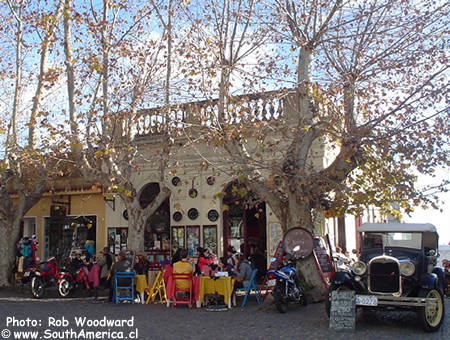
Colonia del Sacramento was founded in January 1680 by Manuel Lobo, the then governor of Río de Janeiro. The city had been in the middle of many disputes between Spain and Portugal and then later between Brazil and Argentina until Uruguay gained its independence.
The historic sector of Colonia was declared a World Heritage site by UNESCO in December 1995. It's cobble-stoned streets and Portuguese-influenced architecture make photo opportunities appear around every corner.
What to see and do in Colonia del Sacramento
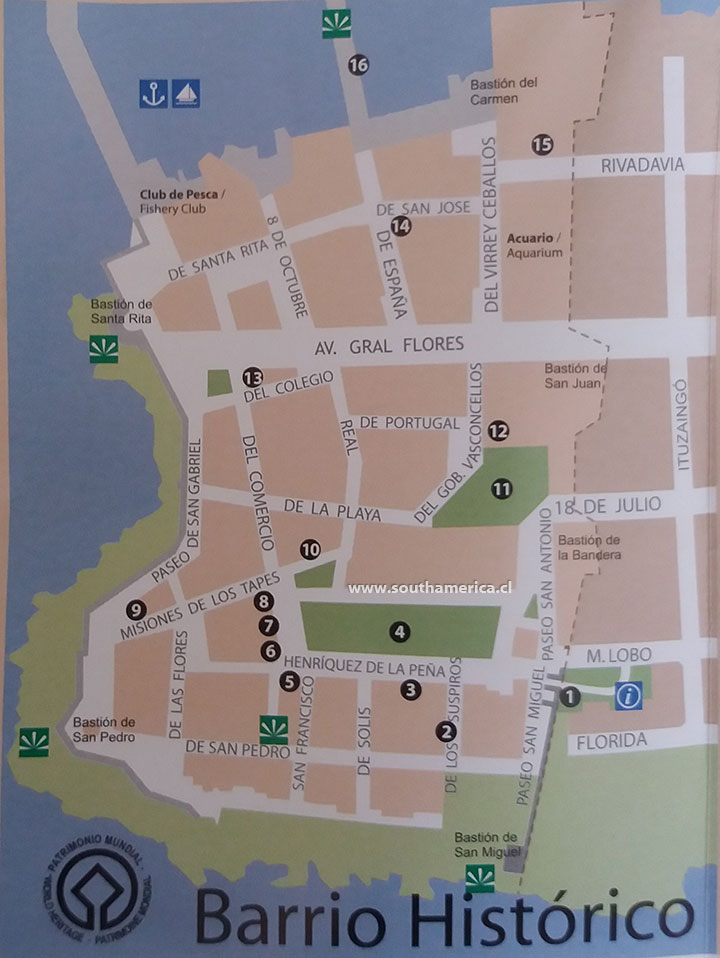
1. Portón de Campo (The Drawbridge Entrance)
The main entrance to the old walled part of the city this drawbridge dates back
to 1745.
2. Calle de los Suspiros (Street of Sighs)
One of the most photographed parts of Colonia, Calle de los Suspiros is literally translated as the Street of Sighs. Why? Probably because you sigh
when you first see it and then utter they words 'How pretty!' To find
out other theories about its origin and also to see some photos, check out:
Calle de los Suspiros.
3. Museo Portugués (Portuguese Museum)
This Portuguese house dates back to 1720 with some Spanish influence added at the end of the same century. It displays 18th century furniture and ceramics as well
as weapons that the Portuguese and Spanish used at the time. There is a display of old maps and an important exhibition is the original shield that used to be
over the drawbridge gate.
4. Plaza Mayor (Main Square)
Where the city was founded is the largest open area in the old city, big enough to practice military maneuvers long ago.
5. a) Ruins of the San Francisco Convent
Originally dating back to between 1694 and 1704, the thick walls of the convent have now mostly fallen down.
5 b) El Faro (The Lighthouse)
The lighthouse was built in 1857 over the ruins of the San Francisco convent. It is normally open every day from 12 to 7pm and there is an entrance fee.
For more information, some photos and a video from the top of the lighthouse,
check out our
Lighthouse of Colonia page.
6. Museo Casa Nacarello (Nacarello's House Museum)
This Portuguese house dates back to the beginning of the 18th century still has its original stone walls and floor. The house has been restored to recreate the
way people lived in the colonial period.
7. Museo Municipal (Council Museum)
Another Portuguese construction dating to the first half of the 18th century, this building had a second floor added to it in the Spanish period (1801).
The building was known as Admiral Brown's house but he may never have actually owned it, just used it. The ground floor museum contains seven rooms
including an archeological room, another that has material once belonging to the Bullring and Royal Casino Hotel of the time (including furniture, weapons, maps)
and also a model of how the town of Colonia was in 1762. On the second floor is a Paleontology room.
8. Casa del Virrey (Viceroy's House)
Ruins of the magnificent Portuguese House of the Virrey.
9. Museo del Azulejo (The Tile Museum)
If you like tiles or collect them yourself, then you will want to visit this museum dedicated exclusively to tiles. This collection once belonged to Jorge
Paéz Vilaró and contains tiles from France, Spain and some of the first ones made in Uruguay in 1840.
10. Museo y Archivo Histórico Regional (The Regional Historical Archives Museum)
A Portuguese house that dates back to 1750 once belonged to the Palacios family. The walls, beams and tiles are all original as are parts of the floor. The
museum holds all the important documentation about the city and the region that has been brought back from Spain, Portugal, England, France and neighboring
countries. These include old maps, police records (1876-1898) and watercolor paintings from 1840 to 1865.
11. Rescate Arqueológico de la Casa del Gobernador (Governor's House)
Foundations of the original Portuguese construction destined as the residence of the city governor. It was destroyed by the Spanish in 1777.
12. Basílica del Santísmo Sacramento
The main church that was next to the now gone governor's house. Check out the domes on top.
There are many restaurants around here with seating outside.
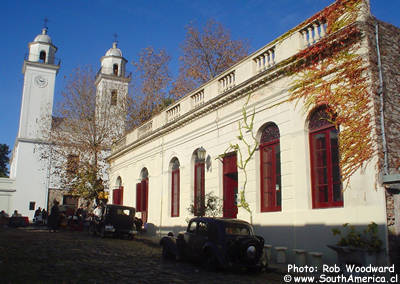
13. Museo Indígeno (Indigenous Museum)
This museum is based on a private collection that Roberto Banchero donated to the city. The exhibitions include artifacts found in the zone that once belonged
to the Churruas Indians including balls, mortars, knives, scapers, arrowheads and ceramics.
14. Museo del Período Histórico Español (Historic Spanish Museum)
This typical Portuguese house dating back to the first half of the 18th century once belonged to a Spanish trader called Juan de Águila. The house still has its
original walls, floors, parts of the roof, some windows and doors. The exhibition displays material that was representative of the first Spanish
families that arrived after 1777. You will find a helmet and sword, documents, Spanish ceramics and clothing, a coin collection and plates with the coat of
arms of different provinces.
15. Centro Cultural Bastión del Carmen (Cultural Center)
A building from 1880 which started as a glue and soap factory, wool laundry and tanning, and later being property of Argentinians was sold to the Ministry of Culture with the purpose of functioning as a cultural center.
16. Muelle 1866 (Wharf)
It was initially longer and with a perpendicular section at the end. Because of weather and general aging, it has lost part of its original structure.
La Plaza de Toros (Bullring) - Not on map
Built in the Moorish style architecture, this bullring that seated 10,000 people was inaugurated on the 9th of January 1910. Despite the large investment
only 8 bullfighting events where ever held here due to a government prohibition of the 'sport' in 1912. Now it is completely abandoned though is still on the
must-see lists of most tourists.
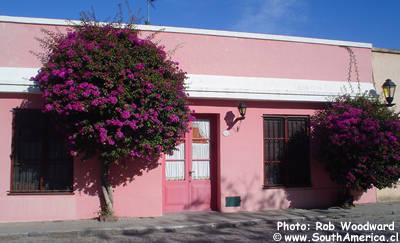
Tours
You can walk around the city by yourself without any problems though if you would like some inside information and tidbits from a local, then you may want to take one of the tours that leave from the tourist information center every day (in front of the drawbridge). The Colonia Tourist Guide Association tours leave at 11am and 3pm every day and on Friday and Saturday evenings they have a special tour that leaves at 6.30pm (with a free sunset thrown in). They cost $100 (Uruguayan Pesos - 2009) per person in Spanish and $150 (Uruguayan Pesos) per person in other languages which need to be booked in advance. The tour takes around one hour.
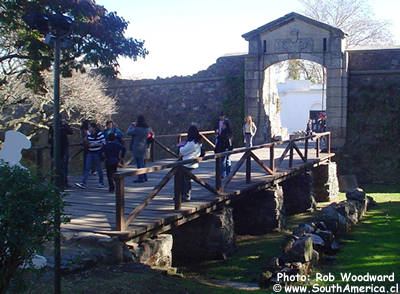
To and From Colonia del Sacramento
There are frequent buses to and from Montevideo.
If you are in Buenos Aires and are interested in getting to Colonia del Sacramento, then you should check out our Buquebus ferry page about how to do it (with photos included).
The best place to see a sunset
If you want to watch a sunset while relaxing on a lawn, the best place to do so is at the Bastión del Carmen. Once where a factory was, the only remaining part is a tall brick chimney. The area now contains a cultural center and if for whatever reason you cannot enter - you need to go through the cultural center's doors - you can get another great view from the yachting club wharf. See the video below for a 360º view from the Bastión del Carmen.
If you found this guide about Colonia del Sacramento, Uruguay interesting or useful, let others know about it.

